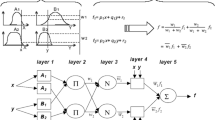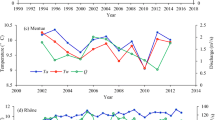Abstract
This paper proposes a dynamic modeling methodology based on a dynamic neuro-fuzzy local modeling system (DNFLMS) with a nonlinear feature extraction technique for an online dynamic modeling task. Prior to model building, a nonlinear feature extraction technique called the Gamma test (GT) is proposed to compute the lowest mean squared error (MSE) that can be achieved and the quantity of data required to obtain a reliable model. Two different DNFLMS modes are developed: (1) an online one-pass clustering and the extended Kalman filtering algorithm (mode 1); and (2) hybrid learning algorithm (mode 2) of extended Kalman filtering algorithm with a back-propagation algorithm trained to the estimated MSE and number of data points determined by a nonlinear feature extraction technique. The proposed modeling methodology is applied to develop an online dynamic prediction system of river temperature to waste cooling water discharge at 1 km downstream from a thermal power station from real-time to time ahead (2 h) sequentially at the new arrival of each item of river, hydrological, meteorological, power station operational data. It is demonstrated that the DNFLMS modes 1 and 2 shows a better prediction performance and less computation time required, compared to a well-known adaptive neural-fuzzy inference system (ANFIS) and a multi-layer perceptron (MLP) trained with the back propagation (BP) learning algorithm, due to local generalization approach and one-pass learning algorithm implemented in the DNFLMS. It is shown that the DNFLMS mode 1 is that it can be used for an online modeling task without a large amount of training set required by the off-line learning algorithm of MLP-BP and ANFIS. The integration of the DNFLMS mode 2 with a nonlinear feature extraction technique shows that it can improve model generalization capability and reduce model development time by eliminating iterative procedures of model construction using a stopping criterion in training and the quantity of required available data in training given by the GT.











Similar content being viewed by others
References
Bacanli UG, Firat M, Dikbas F (2009) Adaptive neuro-fuzzy inference system for drought forecasting. Stoch Environ Res Risk Assess 23(8):1143–1154
Brocard DN, Harleman DRF (1976) One-dimensional temperature predictions in unsteady flows. J Hydraul Eng 102(HY3):227–240
Brown RD, Ouellette RP, Chermisinoff PN (1983) Pollution control at electric power stations: comparisons for U.S. and Europe. Butterworth-Heinemann, Boston
Chang F-J, Chang Y-T (2006) Adaptive neuro-fuzzy inference system for prediction of water level in reservoir. Adv Water Resour 29:1–10
Chaves P, Kojiri T (2007) Deriving reservoir operational strategies considering water quantity and quality objectives by stochastic fuzzy neural networks. Adv Water Resour 30(5):1329–1341
Dixon B (2005) Applicability of neuro-fuzzy techniques in predicting ground-water vulnerability: a GIS-based sensitivity analysis. J Hydrol 309:17–38
Evans D, Jones AJ (2002) A proof of the Gamma test. Proc R Soc Ser A 458:2759
Friedman JH, Bentley JL, Finkel RA (1979) An algorithm for finding best matches in logarithmic expected time. ACM Trans Math Softw 3(3):209–226
Fu DZ, Li YP, Huang GH (2011) A fuzzy-Markov-chain-based analysis method for reservoir operation. Stoch Environ Res Risk Assess. doi:10.1007/s00477-011-0497-1
Gelb A (1974) Applied optimal estimation. MIT Press, Cambridge
Haykin S (1994) Neural networks: a comprehensive foundation. Prentice Hall, Englewood Cliffs
Hong Y-ST, White P (2009) Hydrological modeling using a dynamic neuro-fuzzy system with online and local learning algorithm, Adv Water Resour. doi:10.1016/j.advwatres.2008.10.006
Hong Y-S, Rosen MR, Reeves R (2002) Dynamic fuzzy modeling of storm water infiltration in urban fractured aquifers. J Hydrol Eng 7(5):380–391
Jang J-SR (1993) ANFIS: adaptive-network-based fuzzy inference systems. IEEE Trans Syst Man Cybern 23:665–685
Jobson HE, Keefer TN (1979) Modeling highly transient flow, mass and heat transport in the Chattahoochee River near Atlanta, Georgia. U.S. Geol. Surv. Prof. Pap. 1139
Jones AJ, Evans D, Margetts S, Durrant PJ (2002) The Gamma test. In: Sarker R et al (eds) Heuristic and optimization for knowledge discovery. Idea Group Publishing, Hershey
Kasabov N, Song Q (2002) DENFIS: dynamic, evolving neural-fuzzy inference systems and its application for time-series prediction. IEEE Trans Fuzzy Syst 10(2):144–154
Langford TE (1990) Ecological effects of thermal discharges. Elsevier, New York
Langford TE, Aston RJ (1972) The ecology of some British rivers in relation to warm water discharges from power stations. Proc R Soc Lond B 180:407–419. doi:10.1098/rspb.1972.0027
Lin CT, Lee CSG (1996) Neuro fuzzy system. Prentice Hall, Englewood Cliffs
Maybeck PS (1982) Stochastic models, estimation and control, vol 2. Academic, New York
Polehn RA, Kinsel WC (1997) Transient temperature solution for stream flow from a controlled temperature source. Water Resour Res 33(1):261–265
Sinokot BA, Stefan HG (1993) Stream temperature dynamics: measurement and modeling. Water Resour Res 29(7):2299–2312
Song Q, Kasabov N (2001) ECM—a novel online, evolving clustering method and its applications. In: ANNES 2001, Dunedin, New Zealand, pp 87–92
Stefánsson A, Koncar N, Antonia JJ (1997) A note on the Gamma test. Neural Comput Appl 5(3):131–133
Sun C (1994) Rule-base structure identification in an adaptive network based inference system. IEEE Trans Fuzzy Syst 2(1):64–73
Takagi T, Sugeno M (1985) Fuzzy identification of systems and its applications to modeling and control. IEEE Trans Syst Man Cybern 15:116–132
Theurer FD, Voos KA, Miller WJ (1984) Instream Water Temperature Model. Instream Flow Information Paper 16, FWS/OBS-84/15. U.S. Fish and Wildlife Service
Wang L, Mendel JM (1992) Fuzzy basis functions, universal approximation, and orthogonal least squares. IEEE Trans Neural Netw 3(5):807–814
Acknowledgment
This work was supported by Genesis Power Ltd. New Zealand.
Author information
Authors and Affiliations
Corresponding author
Rights and permissions
About this article
Cite this article
Hong, YS.T., Bhamidimarri, R. Dynamic neuro-fuzzy local modeling system with a nonlinear feature extraction for the online adaptive warning system of river temperature affected by waste cooling water discharge. Stoch Environ Res Risk Assess 26, 947–960 (2012). https://doi.org/10.1007/s00477-011-0543-z
Published:
Issue Date:
DOI: https://doi.org/10.1007/s00477-011-0543-z




